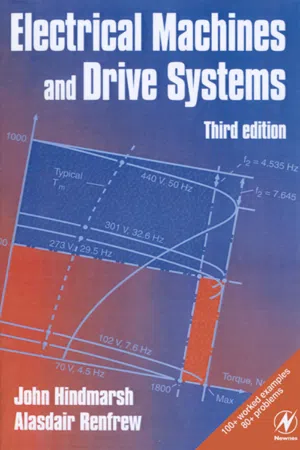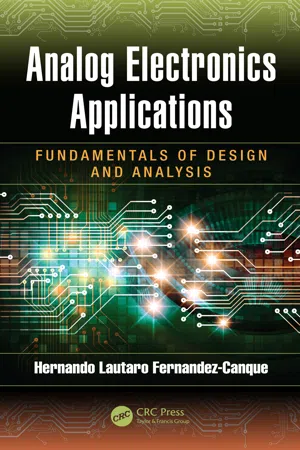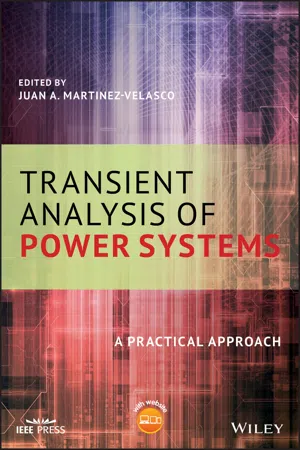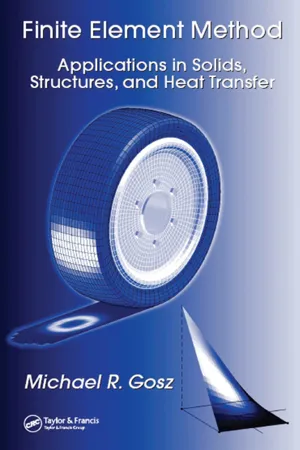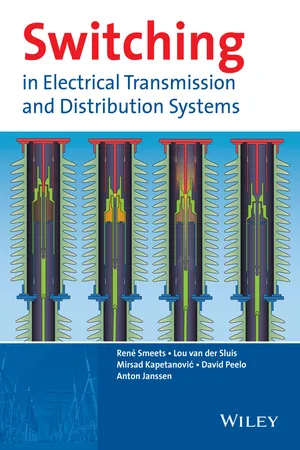Physics
Transient Analysis
Transient analysis in physics refers to the study of a system's behavior during the transition from one steady state to another. It involves examining how the system responds to sudden changes or disturbances. This analysis helps in understanding the dynamic behavior of physical systems and is commonly used in fields such as electrical circuits, mechanical systems, and thermodynamics.
Written by Perlego with AI-assistance
Related key terms
5 Key excerpts on "Transient Analysis"
- eBook - ePub
- John Hindmarsh, Alasdair Renfrew(Authors)
- 1996(Publication Date)
- Butterworth-Heinemann(Publisher)
Chapter 6Transient behaviour; closed-loop control
So far, nearly all the examples have been concerned with steady-state behaviour. It is important however to introduce the ideas underlying the equally significant behaviour which occurs during the approach to, or the retreat from, a particular steady state. The transient state is a very interesting field for mathematical and computer experts, but it is still possible to study many practical aspects of machine transients without going much beyond the theory of the first-order differential equation. Thermal, electrical and mechanical transients are all partly covered by such simple equations, though clearly these will have to become more complex as more elements and control circuits are included in the system of which the machine may be only the main power unit. Usually the machine has a much larger time-constant than the control and power-electronic time-constants, so has a dominant effect and will be the area of study in this chapter as a simple introduction to the topic. Even for the machine itself, the mechanical time-constant is usually much greater than the electrical time-constants and so the electrical and mechanical responses can often be studied separately. The meaning of this is that the electrical-system changes take place at virtually constant speed and the mechanical changes take place after the electrical system has virtually reached its steady state. This particular problem will be discussed in illustrative examples but of course in the space available, the coverage of the transient state can only be limited and selective.The manner of response in which a system gets from one state to another is often highly important in drive design, the principal features being speed of response, stability and accuracy in meeting an input demand. The stress placed on components is also important. The speed of response may be represented by time constant, settling time or rise time; stability may be represented by the damping ratio, which is a measure of how many oscillations, if present, exist before these die away; accuracy reflects whether the steady state reached is exactly the required value or if a steady-state error exists. The response is made up of two parts: a steady-state response which remains until conditions change and a transient response which should decay to zero. - eBook - ePub
Analog Electronics Applications
Fundamentals of Design and Analysis
- Hernando Lautaro Fernandez-Canque(Author)
- 2016(Publication Date)
- CRC Press(Publisher)
3 Circuit Analysis 3.1CONCEPT OF STEADY STATE AND TRANSIENT SOLUTIONSWhen an external energy is applied to a circuit, through either the connection of a voltage or current source, some components will not respond instantaneously to this stimulus. In particular, capacitors and inductors can absorb or dissipate energy in a finite time. This means that the total response of circuits consists of two parts: the transient response and the permanent or steady-state response. The total response then will be the sum of the transient response plus the steady-state response.The transient response is a response that takes place in a very short period of time. It is the time for the circuit to settle before it reaches a permanent state. This transient response is a response to changes in the circuit; changes in a circuit can be due to the closing or opening switches or any sudden variation in a circuit. The transient response also depends on the state of a component previous to its connection to a circuit. For example, if a capacitor is connected to a circuit, and this capacitor has been precharged, the response will be different than if the connected capacitor was discharged. In circuit analysis this is known as the initial condition of a component. Usually it is an initial voltage for a capacitor or an initial current for an inductor. The transient response only remains for a very short period of time usually in the order of milliseconds and is the reaction of a circuit to instantaneous changes. The charging or discharging of a capacitor, and the energizing or de-energizing of an inductor will take time to settle into a permanent response.The steady-state response, also known as permanent response, is the response of a circuit after the time engaged by the transient response has been completed. In this chapter, we will concentrate on the steady-state response of a circuit.When an ac signal is applied to a circuit, voltages and currents change as the time varies. A solution of an ac circuit is time-dependent. If the signal is a periodic signal, it is possible to use a method based on the variation of the amplitude and phase of the response to make it artificially independent of the time variation. In this chapter we will discuss this method by introducing the concept of phasors and working in the frequency domain instead of the time domain. - eBook - ePub
Transient Analysis of Power Systems
A Practical Approach
- Juan A. Martinez-Velasco, Juan A. Martinez-Velasco(Authors)
- 2019(Publication Date)
- Wiley-IEEE Press(Publisher)
18 ]. A tool for simulating the behaviour of a power system during a transient phenomenon must also include capabilities for calculating the steady‐state solution prior to the beginning of the transient. The chapter summarizes solution techniques for the computation of electromagnetic transients using single‐phase representations, solutions to the numerical oscillations produced by the trapezoidal rule, methods to obtain initial steady‐state solutions, and procedures to solve control systems and the interface between power networks and control systems. The last section presents a short overview of solution methods implemented in other transients tools.3.2 Modelling of Power System Components for Transient Analysis
The goal of a power system is to satisfy the energy demand of a variety of users by generating, transmitting, and distributing the electric energy. These functions are performed by components whose design and behaviour are very complex; as a consequence, the analysis of transient phenomena in power systems is a difficult task due to the complexity of power components and the interactions that can occur among them.The performance of power system components during a transient phenomenon depends on their design and dimensions, as well as on the nature of the transient phenomenon. Voltages and currents propagate along conductors with finite velocity; so, by default, certain models for electromagnetic Transient Analysis should consider that electrical parameters are distributed. Only when physical dimensions of those parts of a component affected by a transient are small compared with the wavelength of the main frequencies, a representation based on lumped parameters could be used. The selection of the most adequate representation of a power component in transient simulations is not an easy task due to the frequency ranges of the transients that can appear in power systems and to the different behaviour that a component can have for each frequency range.However, a representation valid throughout a wide range of frequencies is not practically possible for most components. Consider, for instance, the behaviour of a transformer during electromagnetic transients. A transformer is a device whose behaviour is dominated by magnetic coupling between windings and core saturation when transients are of low or mid frequency. However, when the transients are caused by high‐frequency disturbances, such as lightning strokes, then the behaviour of the transformer is dominated by stray capacitances as well as capacitances among windings. Modelling of power components, taking into account the frequency dependence of parameters, can be practically made by developing mathematical models that are accurate enough for a specific range of frequencies. Each range of frequencies usually corresponds to some particular transient phenomena. See Chapter 2 - eBook - ePub
Finite Element Method
Applications in Solids, Structures, and Heat Transfer
- Michael R. Gosz(Author)
- 2017(Publication Date)
- CRC Press(Publisher)
8Linear Transient Analysis
The first pull on the cord always sends the drapes in the wrong direction.—Boyle’s Other LawAn important decision that must be made during the analysis of solids and structures is whether to perform a static analysis, a quasi-static analysis, or a dynamic analysis. In a static analysis, all variables in the problem, such as applied load and material properties, are assumed to be independent of time. Inertia is also neglected. In a quasi-static analysis, the loads and material properties can depend on time, but again inertia is ignored. Viscoelastic behavior and creep are examples of time-dependent material models. In a dynamic analysis all variables in the problem can depend on time, and inertia effects are included.In general, it is appropriate to perform a static analysis when the natural frequency of the external loading is much lower than the lowest natural frequency of the structure. A rule of thumb is that a static analysis is sufficient when the frequency of the loading is less than one-tenth of the lowest natural frequency of the structure. When the frequency of the loading is above this threshold, inertia effects become important and should not be ignored.Transient problems in solids and structures can be separated into two categories: wave propagation and structural dynamics. In wave-propagation problems, the frequency of the external loading is very high. Blast and impact loading are common examples. In wave-propagation analyses, the time duration of the event is, in general, very small — on the order of milliseconds to microseconds. Hence, it may be important to capture the high-frequency information such as stress wave propagation that occurs within these small time scales. In structural dynamics, the main concern is the overall motion of the structure without regard to the high-frequency (small time scale) information. Here the events are on the order of seconds to minutes, or longer. - René Smeets, Lou van der Sluis, Mirsad Kapetanovic, David F. Peelo, Anton Janssen(Authors)
- 2015(Publication Date)
- Wiley(Publisher)
5 Calculation of Switching Transients5.1 Analytical Calculation
5.1.1 Introduction
Switching operations, short-circuits, and disturbances during normal operation often cause temporary overvoltages and high-frequency oscillations. The power system must be able to withstand the overvoltages as well as lightning strokes without damage to the system components. The calculation and simulation of transient voltages and currents is of great importance for the insulation coordination, correct operation, and adequate functioning of the system protection.Transient phenomena can occur in different time frames, such as:- microseconds – in the case of the initial rate-of-rise of the transient recovery voltages and short-line faults;
- milliseconds – when looking at transient recovery voltages caused by switching actions; or even
- seconds – for instance, in the case of ferroresonance (see Section 10.6).
Calculation of transients in power systems is treated in many books [1–9]. A practical approach, taking into account the application of switchgear can be found in application guides, related to the relevant standards [10, 11]. Calculation of transients generated by current interruption is treated extensively in a new book [12].The following sections give examples of analytical solutions to the relevant differential equations and numerical simulation of electrical transients. The mathematical expression for asymmetrical current described in Section 2.1 is derived in Section 5.1.2. Section 5.1.3 provides the derivation of the expression for TRV originating from two oscillating circuits separated by the switching device – the source-side circuit and the load-side circuit, described earlier in Section 1.6.2.Transients depend on the voltage and topology of the network and on the short-circuit power of the system. They usually comprise components caused by travelling waves on HV transmission lines and underground cables, oscillations due to lumped network elements, generators, transformers, and so on.
Index pages curate the most relevant extracts from our library of academic textbooks. They’ve been created using an in-house natural language model (NLM), each adding context and meaning to key research topics.
